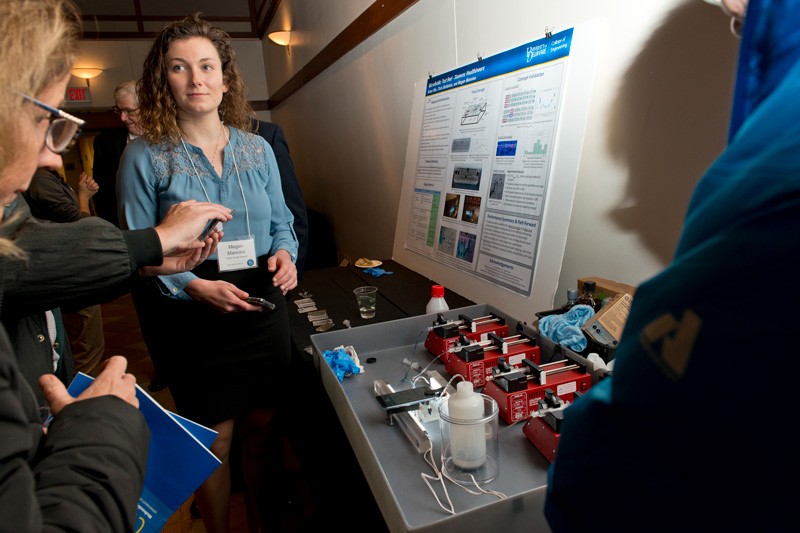Photos by Lane McLaughlin
Through Senior Design, engineering students flex their skills
Megan Mannino, a senior majoring in biomedical engineering, was intrigued by microfluidics—the study of fluid behavior at a submillimeter scale—when she first learned about the subject during a technical engineering elective course.
For her final project before graduating from the University of Delaware this winter, Mannino and two classmates built a microfluidics technology testbed to help Siemens Healthineers Diagnostics explore the feasibility of utilizing microfluidics technology in high-throughput clinical analyzers.
Clinical analyzers are used to evaluate samples of bodily fluid. Perhaps your doctor draws blood to check your cholesterol levels or asks you to urinate in a cup to check for signs of a urinary tract infection. The sample goes into in a clinical analyzer, a machine that mixes the sample with one or more special chemicals, called reagents, that elucidates whether the sample is normal or not.
The problem with clinical analyzers is that they are huge—taking up one or more rooms of many healthcare facilities. A system with a smaller footprint could bring big benefits.
“Hospitals are already low on space, as well as people, to do these tests,” said Mannino. “Microfluidics could revolutionize healthcare.”
Using pumps, an imaging system, and specially designed acrylic chips, Mannino’s team built a testbed that merged water-based and oil-based fluid droplets, one by one. With more research, a similar device could be developed to merge individual drops of blood, plasma, or urine with individual drops of reagent, allowing for meaningful analysis of patient samples.
The team’s biggest challenge was closing off the system so that the droplets, guided by the grooved acrylic chips, always landed where they were supposed to. After six or seven weeks of back-and-forth effort, they found a paper in an academic journal that posed the perfect solution: duct tape.
Duct tape can indeed fix everything—but it helps to have engineering skills that help you solve the problem 99 percent of the way first. The team had to stretch their skills to construct the device, develop software to run it, and to communicate their findings to the public—an important skill that employers look for.
By December, the team explained their device to a room full of people, including expert judges. It was all part of Senior Design, a six-credit interdisciplinary capstone engineering course.
“Senior Design has probably been the most valuable part of my undergraduate degree,” said Mannino.
Senior Design
During the fall semester of 2019, Senior Design brought together 141 students, including all seniors majoring in mechanical engineering and biomedical engineering as well as some students majoring in electrical and computer engineering and civil and environmental engineering. The students were divided into 36 teams guided by 13 faculty advisors. Projects were sponsored by industrial, clinical and academic partners.
“What stood out most in senior design this year was the excellent interdisciplinary integration and teamwork, which enabled engineering seniors to make the best possible prototypes in the shortest possible time,” said Ashutosh Khandha, an assistant professor of biomedical engineering. “It was exhilarating to see students working with industry, business and clinical sponsors, and thriving in a real-world environment.”
Ariel Hannum, an honors student majoring in biomedical engineering, worked on a project to develop a magnetic resonance-compatible oscillatory lower body negative pressure device that would allow the UD Neurovascular Aging Laboratory to examine the relation between intracranial pressure and brain integrity using a noninvasive brain scanning method.
“This project combined different aspects of engineering, from mechanical skills to knowledge of electrical components,” said Hannum.
In other words, the project helped Hannum sharpen existing skills and build new ones.
“This has been an accumulation and application of what we’ve learned in our classes,” said Hannum. “In life, you won’t always have all the skills and background you need when you start solving a problem, but you can build upon your foundation to solve it.”
Matthew Hardie, a mechanical engineering major, worked on a project to develop a universal tooling interface for planetary excavation robots. The project was sponsored by the Delaware Space Grant Consortium.
Hardie was drawn to the project because he knew it would incorporate computer aided design and mechanism design, areas in which he is already skilled, while introducing new challenges at the same time.
“The fact that this device has to hold up to the harsh environments on other planets is what made the project new and exciting,” said Hardie.
The team came up with 20 or more ideas before they decided on a final concept that could meet size and load requirements. They tested their device at NASA’s Glenn Research Center in Cleveland, Ohio, and were happy with its performance. The team plans to continue refining their design in the spring 2020 semester as an independent study.
“Every year, I am more and more impressed with the sophistication of the prototyping,” said Jenni Buckley, associate professor of mechanical engineering. “Just when I think we’ve peaked as a program, the students again exceed the mark. I think our emphasis on hands-on fabrication and computer-aided design in the early years of our curriculum is paying off. By the time these students are seniors, they’re able to produce a Gen 1 prototype by midterm, field test it, and make improvements by the time of the showcase in December. It’s impressive, and I think this early, consistent focus on design is what makes all of the difference.”


